How to hang a painting and other objects on a drywall wall?
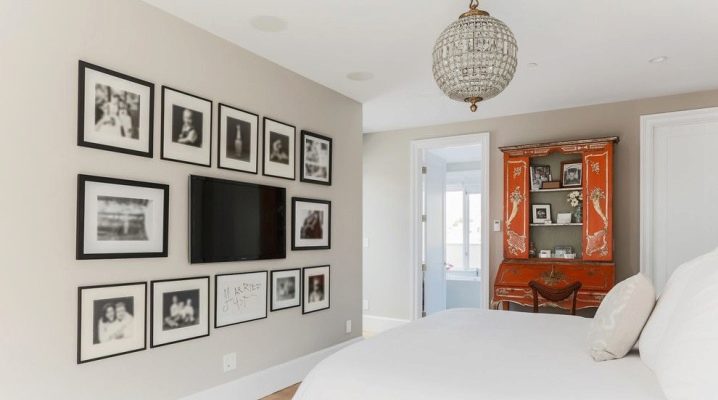
In modern interior design, plasterboard wall decoration is quite common. With the help of gypsum board, walls are leveled, niches, partitions and even cabinets with shelves are created. Working with drywall sheets does not require special skills, the material itself is simple, lightweight and economical, and the result always looks neat.
Peculiarities
In fact, the gypsum plasterboard is a solid gypsum board pasted over with thick cardboard. The cardboard protects the panel from cracking and spilling, and also allows screws and self-tapping screws to be screwed into the panel. When, after repair, it is necessary to arrange furniture, household appliances and other interior items, the question arises of how exactly to hang a heavy TV or shelf, because the drywall sheet itself is quite fragile, it will not withstand something heavier than a photo frame.
There seems to be no way out of this situation., however, if you evaluate all the advantages and disadvantages of a particular fastening system and choose the right one, you can always find a way to place even the heaviest structure on such a wall.
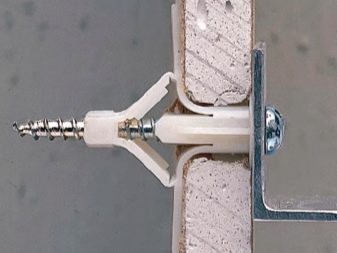
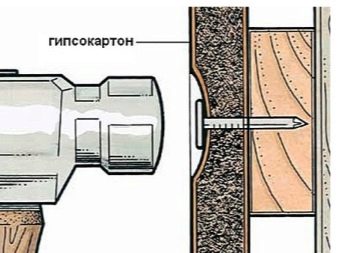
How can you fix it?
Experienced builders claim that a plasterboard wall can withstand a load of up to 55 kilograms per fastener, it is only important to choose the right fastener. There are several types of fastening systems used when decorating a plasterboard room. Most often, various dowels are used, which are screwed only into the drywall sheet itself, without reaching the wall behind it.
Various devices allow the plastic, nylon or iron part of the dowel to open in the void behind the gypsum board and press against it from the back side, which significantly increases the strength of such an attachment.

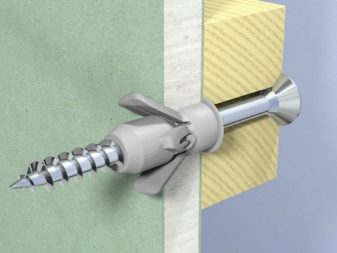
Types of dowels that allow you to hang an object weighing no more than 35 kilograms:
- universal dowel (withstands a load of up to 3 kg);
- dowel "drive" (up to 30 kg);
- dowel "umbrella" (no more than 6 kg);
- dowel "butterfly" (withstands a load of up to 10 kg);
- dowel "hartmut" or "mole" (within 35 kg).



If it is necessary to hang an object weighing more than 35 kilograms, it is not enough to use a dowel as an attachment - additional installation of auxiliary elements is required.
- Installation of mortgages. In this case, it is necessary in advance, even before installing the plasterboard walls, to outline the places where this or that equipment and furniture will hang. In these places, a wooden beam or shield is attached to the concrete, into which the fastening mechanisms behind the drywall will then be screwed in.
For all its reliability, mortgages have one big drawback: it is necessary to plan in advance the entire environment of the room in order to take into account where and at what height to fix the timber to the gypsum board.

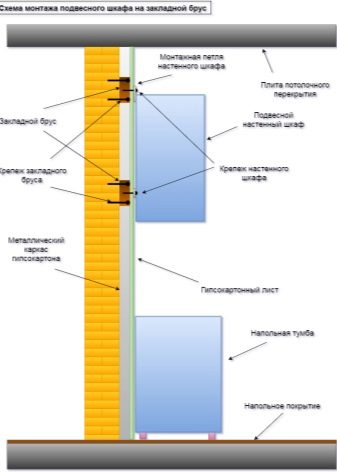
- Installation of a horizontal bus. Some sets of modern furniture sets include a special metal strip with holes for fasteners and folds for hanging shelves and cabinets. It is mounted along the entire length of the wall and allows you to more evenly distribute the load on the drywall.
It is also advisable to mount such a tire on a wooden beam or metal profile previously laid behind the drywall, or use anchor bolts to fasten the tire itself.



- Anchor fasteners. This type of fastener is only suitable for solid walls, not plasterboard partitions.When installing the anchor, a small hole is cut out in the plasterboard wall, which allows you to drill a concrete wall with a puncher and insert a metal dowel into it, into which the anchor bolt itself will be screwed.
This mount is the strongest and allows you to hang even the heaviest household appliances and massive kitchen cabinets on the walls. At the same time, it is also the most expensive in terms of installation time and cost of materials.

If necessary, place small decorative elements in the form of a mirror on the wall, shelves or pictures, you can use a universal dowel or the "drive" model. Before using a regular dowel, you need to drill a hole with a diameter of 8 millimeters, insert a polypropylene part and screw in the self-tapping screw itself. The plastic part expands during the screwing in of the metal and adheres firmly to the drywall.
Unlike the universal one, the "drive" dowel does not require a screwdriver or drill. It is screwed directly into the gypsum board without preliminary drilling. Most often, a plastic version of the product is used to prevent the drywall from crumbling or cracking.


For hanging medium-heavy objects on a plasterboard wall, the "umbrella" dowel is perfect. Made of metal in the form of a hook or a simple screw, it opens up behind the drywall like the spokes of an umbrella and distributes the load on the gypsum board evenly. In order to install such a mount, you need to drill a hole into which you need to insert the fastener and screw the screw itself. Such fasteners will be an excellent solution in order to hang a sconce or a chandelier.


The butterfly dowel is made of nylon. When a self-tapping screw is screwed into it, it opens in two directions, like open wings, and rests on the seamy side of the drywall, for which it got its name.
The strongest are the "mole" and "hartmuth" dowels. The first is a metal structure with side slots and a screw screwing into it. In the gypsum board, it is necessary to drill a hole with a drill, suitable for the size of the dowel, slightly bend the wings of the "moth" and screw it all the way into the hole. To fix the Hartmut dowel, you need to drill a hole with a diameter of 13 millimeters and insert the fasteners into it with the spacer folded down. Then the dowel is pulled out, and the spacer part, opening up, is pressed against the wrong side of the gypsum board. It is necessary to fix it and break off the excess.

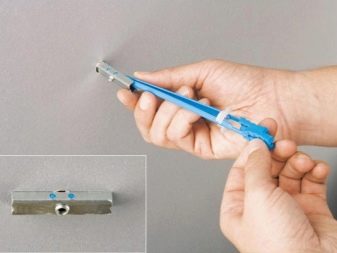
On the kitchen
Most often, the problem of fixing certain items on the gypsum board arises when placing furniture in the kitchen. To save space, part of the kitchen set is hung on the wall above the work surface. Even the lightest box weighs about 7-15 kilograms, and various dishes, food and other household items are also placed in it. Thus, the average weight of a filled kitchen cabinet ranges from 20 to 50 kilograms, depending on the material of the furniture itself.
Such a weight can withstand the anchoring, or it is necessary to make wooden mortgages in advance behind the walls of plasterboard in those places where it is planned to hang the upper boxes.
For medium-weight items such as a chandelier, open shelves or paintings decorated with a wooden molding, you can use a "driva" or "hartmut". For attaching small light objects such as curtain rods, curtains or wall clocks, a butterfly or umbrella will suffice. Ordinary U-dowels can be used to hang portraits of family members or friends. It is also very convenient to attach the plinths to the plasterboard wall with ordinary dowels, since the use of glue can destroy the cardboard layer that keeps the gypsum in a dry pressed state.

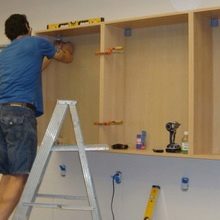

In bathroom
The biggest problem with plasterboard mounting in a bathroom is wall-mounted water heaters. There are two types of water heaters: flow and storage.There should be no problems with the mounting of a flow-through boiler, since it weighs on average up to 10 kilograms and is mounted using dowels of the "butterfly" or "drive" type. However, such water heaters have a significantly higher price and consumption of electricity, therefore, storage boilers are most often used in bathrooms. The average weight of such a drive varies between 80-100 kilograms - not a single drywall wall can withstand it.
It is possible to reduce the load on the gypsum board by using the methods of preliminary bookmarking or mounting on a pre-installed metal reinforcement. Both methods can be used only if you know exactly the dimensions and weight of the purchased water heater even before installing the plasterboard coating. If the repair has already been done, and it is necessary to hang the heater, a chemical anchor can come to the rescue. This method of fastening is implemented using a special chemical solution similar to polyurethane foam. Expanding and freezing, this solution firmly fixes a metal pin inserted into it, on which an apparatus weighing 80 kilograms can be hung.
You can also hang the sink and fix the cabinet above it with the help of a "driva" or "hartmouth", and for a shelf and a mirror you can use, for example, a "butterfly" dowel.



In the hall
In the hallway, there are usually no heavy objects that require hanging on the wall. As a rule, all furniture is placed on the floor: a wardrobe, a bench or a shoe rack. A small lamp and a hanger are attached to the wall, but ordinary dowels or "umbrellas" are enough for them. In some cases, a horizontal bar can be hung, for which a preliminary laying or anchoring is required.



Tips and mistakes
A beginner who has not previously encountered a solution to such problems, can easily overlook some important details:
- When installing mortgages, you will have to photograph the finished work from different angles or draw up a plan-diagram so as not to forget the exact location of their location. Otherwise, it is very easy to miss the specially set mortgage.
- Do not hang very heavy objects on the dowels, even if they reach brickwork or concrete. Even the strongest dowel will eventually bend and deform the gypsum board, so it is necessary to use anchoring.
- For any fastening, it is better to use several dowels or anchors - this way the load will be distributed more evenly, and the probability of the fastening falling out will be significantly lower.
- If the drywall is not yet covered with wallpaper and painted, you can clearly see the location of the metal profile at the joints of the sheets. Unlike the cover itself, the profiles are made of metal, they are less susceptible to deformation, so a heavy object can be hung on the wall by screwing the mount exactly into the metal base.
- It is always better for a beginner to choose a more secure mount, even if you only have to hang a small picture or a shelf with a flower pot.


Successful examples and options
The TV mounting bracket will be mounted on a wooden tab, reinforced with a metal plasterboard profile. Such a bookmark is preliminarily planned and installed even before the wall cladding with plasterboard. Such a fastening will allow you to use even simple dowels, which will be firmly fixed inside a wooden beam.
A mounted horizontal rail is used to fasten the upper part of the kitchen unit. Such a fastening will significantly reduce the point load on the gypsum board and distribute the weight of the hung cabinets over a large area.
Installation on a pre-assembled metal reinforcement is also used. The fasteners will interact not with fragile drywall, but with a strong metal profile, attached in turn to the concrete wall.



Placing household appliances and pieces of furniture on the walls can significantly save space in small rooms and rooms.
For various methods of fastening to drywall, see the video.













The comment was sent successfully.